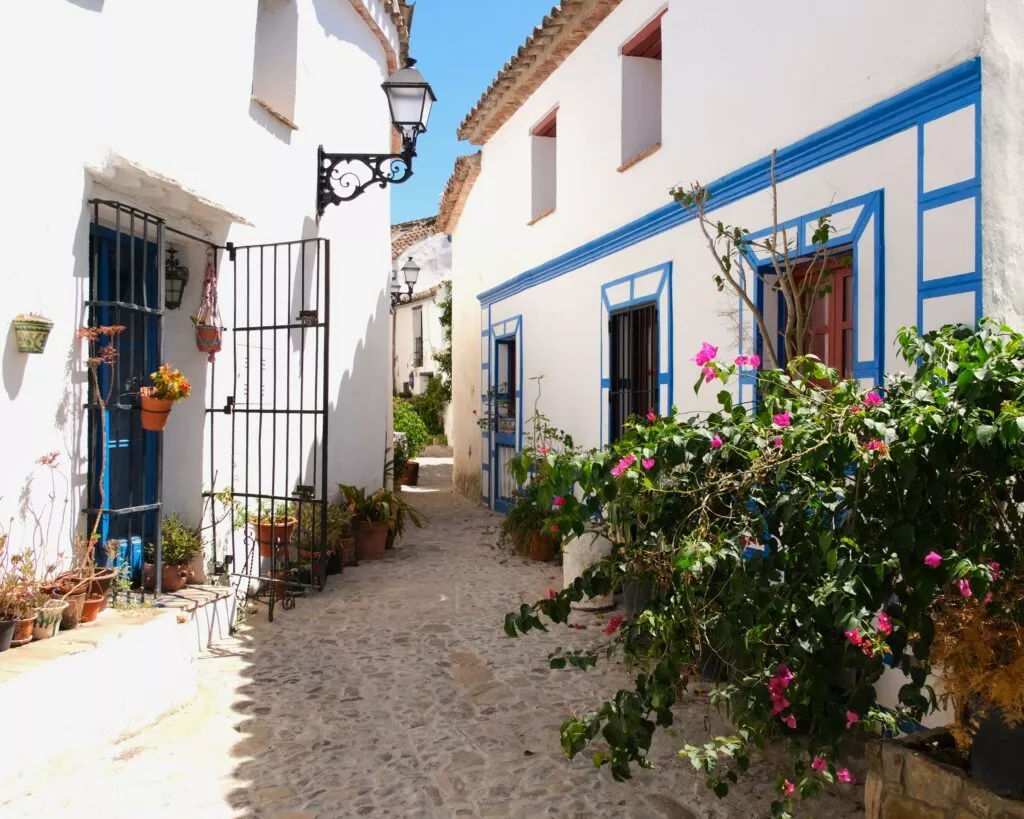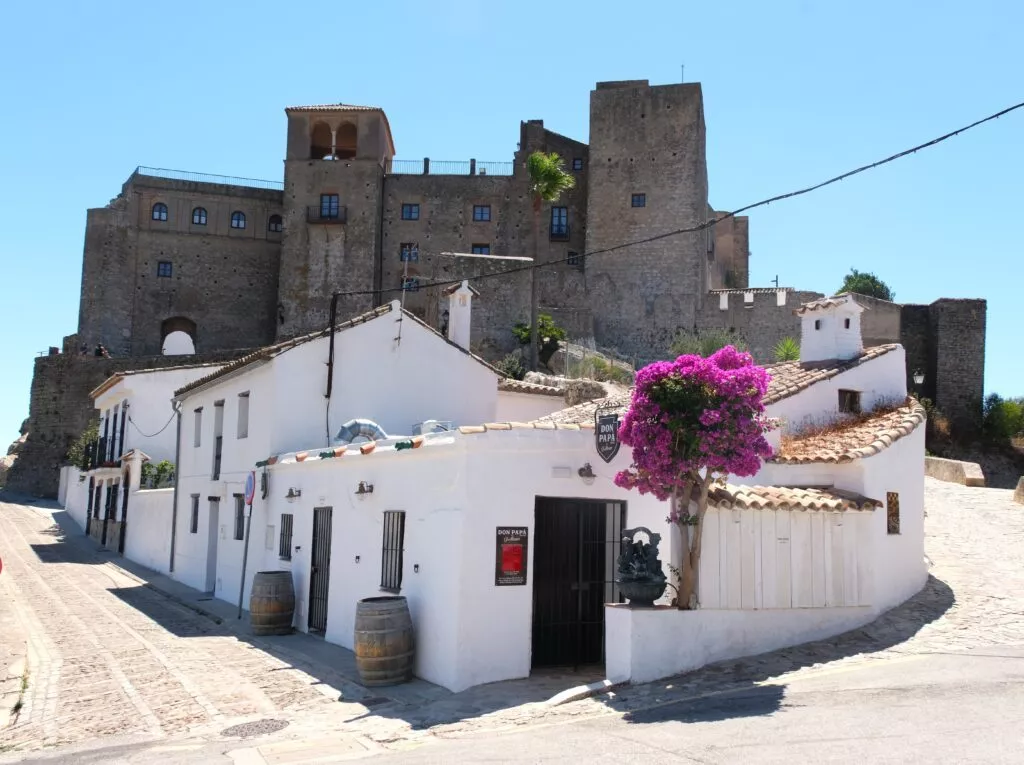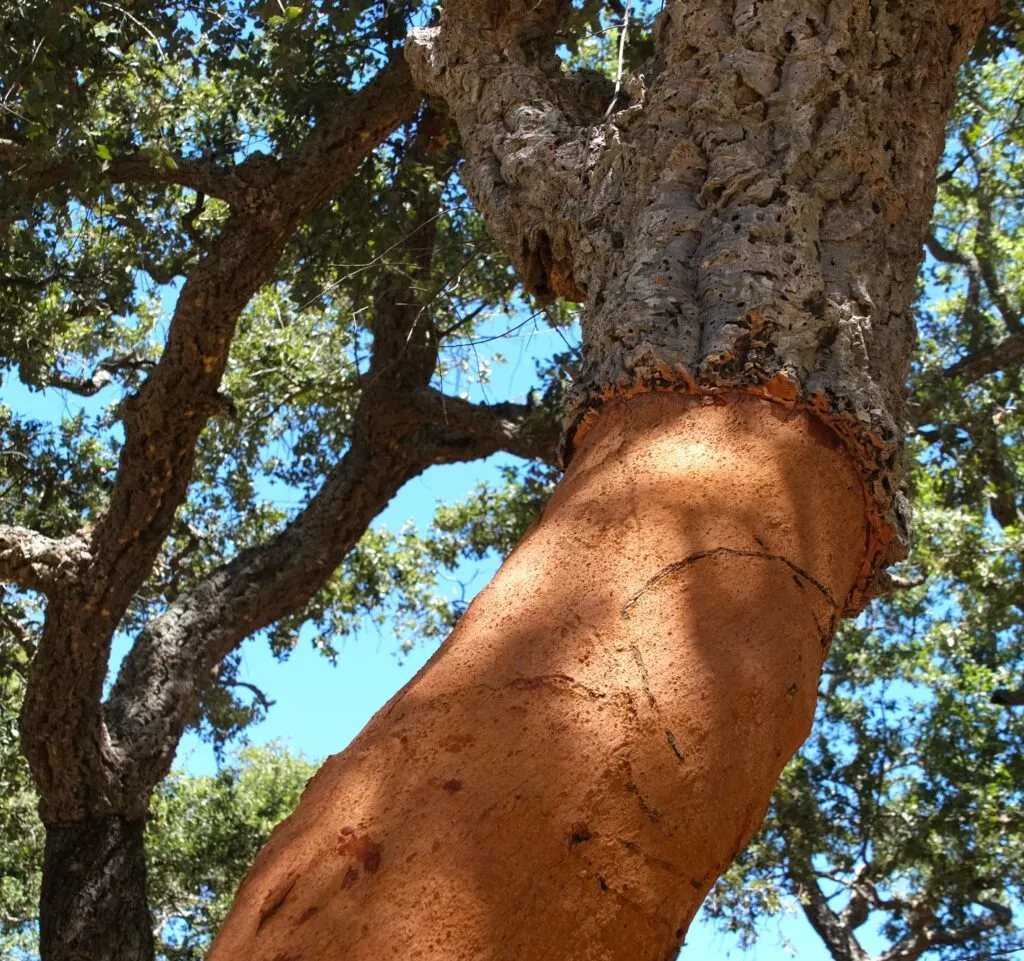Castellar de la Frontera a unique white village in Andalucia
The essential things to see in Castellar de la Frontera
In this article you’ll find all the information you need to visit Castellar de la Frontera and find out everything there is to see:
- A few words about Castellar de la Frontera
- Where is Castellar de la Frontera on the map?
- What to see in Castellar de la Frontera
- What to do in the area
- Book accommodation
- The main festivities in Castellar de la Frontera
- What to see in the Castellar area
- Useful links
- Continuing your trip to Andalucia

A few words about Castellar de la Frontera
Castellar de la Frontera is a village in the province of Cadiz, in the Los Alcornocales Natural Park.
We’re going to explore the oldest part of Castellar de la Frontera. It’s a magnificent, authentic and timeless village, perched on the top of a mountain.

This village is unique in its structure. It lies entirely within the walls of a medieval fortress. The interior of the castle is one of the few existing examples of an inhabited core inside a fortification. See below for an aerial view of the village (a photo from the town hall website).

It is reached by road from the new Castellar de la Frontera, built in 1971. You take a 10km road that climbs through a cork oak forest. Once you arrive, this village offers an incredible spectacle of beauty and authenticity.
Castellar de la Frontera has been part of the Pueblos más bonitos de España network since 2019.

The history of this place in a few words
Thanks to its strategic position at the top of a mountain, this small area of Castellar has been a settlement for many civilisations since time immemorial.
The earliest evidence of human presence is the extensive lithic industry found in caves all around. This indicates that Palaeolithic and Neolithic man occupied these lands.

What’s more, the presence of cave paintings in these cave shelters confirms the presence of prehistoric man.
Castellar de la Frontera is located in a fortress that served as a bulwark against attacks by Christian troops from the 12th to the 15th century.

Castellar, with its inhabitants inside the fortress, played a fundamental role in the wars between Castilians and Muslims.
It remained under Moorish rule until 1434, when D. Juan Arias de Saavedra conquered the town and incorporated it into the Crown of Castile.

Curiosity: The old village of Castellar de la Frontera has been nicknamed by some the little Carcassonne. The funny thing is that in the 8th century, the 2 villages belonged to the Umayyad caliphate, ruled from Damascus. I’m talking about the time of the Wâli of Narbonne (725-759). A time when Narbonne was called Arbunah, Nîmes: Nimah, Agde: Ajdah, Béziers: Bazyih and Carcassonne….Qarqachounah.
Where is Castellar de la Frontera on the map?
What to see in Castellar de la Frontera
This village is a total delight for lovers of white villages, tranquillity and history, off the beaten track.
1 – Stroll through the old town of Castellar de la Frontera
2 – The Plaza de Armas
3 – The fortress
4 – The church of Divino Salvador
5 – Enjoy the views
6 – The lovers’ balcony
7 – View of the Rock of Gibraltar and Africa
8 – The cork oak forest
9 – The monarch butterfly trail

Note: What’s particularly curious about this village is that it was more or less saved from abandonment by hippies in the 1970s. A number of young hippies from Nordic countries settled in the village after the inhabitants left to live 10km away in the new Castellar de la Frontera. A community was thus created, living from handicrafts. You’ll still find some of these craft workshops in the village.
1 – Take a stroll through the old town of Castellar de la Frontera
The interior of the village is of incredible aesthetic beauty. Every house, every alleyway deserves a photo.

It’s an incredible pleasure to wander through the narrow, winding streets of the village.

And to take the time to admire the charm of each whitewashed house decorated with flowerpots.
The layout and structure of the houses are a reminder of the centuries of Muslim rule.
Flowerbeds, potted plants and vines naturally decorate the balconies and small squares of the streets of Castellar Viejo.

Every corner of the village is a postcard photo – I don’t know if the youngest readers of this article will understand this image 🙂 – but young people will be able to embellish their Instagram accounts with pretty photos of this Andalucia atmosphere.
In some places there are also pretty bougainvilleas alongside the houses.

This village hidden behind the walls of a fortress, made up of narrow streets, nooks and crannies and small squares, was declared a Historic and Artistic Monument in 1963.
2 – Plaza de Armas
The Plaza de Armas is where you enter the village after passing through the Puerta de la Villa. A beautiful place to start your visit to Castellar de la Frontera.

3 – The fortress
Castellar de la Frontera Castle is a Nasrid fortress used between the 12th and 15th centuries. It acquired great importance in the wars of the time between Christians and Muslims.
It served as a rear base for controlling the Straits of Gibraltar. This fortress was part of the defence system of the kingdom of Granada.

After the conquest, it became the Palace of the Counts of Castellar – the House of Saavedra – and in the mid-18th century, the House of Saavedra was united with that of Medinaceli.

Between the church and the fortress stands an unusual architectural feature: an algorfa. In this case, the algorfa linked the fortress to the mosque. This alleyway served as a passageway for the lords of the castle.

Note: I have not been able to find out whether the algorfa dates from the Muslim period or whether it was built later. In the latter case, the footbridge would have been used by the castle’s nobles to go straight to the church for mass.
This castle-fortress has also become a hotel… more on that below.
4 – The church of Divino Salvador
The church of El Divino Salvador is a 17th-century Gothic-Mudejar church. As was customary after the Castilians conquered a Muslim stronghold, the Christians built a church over the town’s former mosque. Changing a religious temple has always been a way of consolidating power.

However, since the 1970s the church has been desanctified and is no longer a place of worship. It is now used as an exhibition hall and arts centre. However, it has retained its high ceilings with wooden beams. Below is a photo of the terrace of this former temple:

Note: It is worth mentioning its magnificent Mudejar coffered ceiling, a unique and rare feature in the area. In Setenil de la Bodegas, you’ll probably find the most beautiful Mudéjar coffered ceiling in the whole province in the tourist office building.
5 – Enjoy the views
Thanks to the village’s privileged position at the top of a mountain, the views are all magnificent.

You can enjoy a magnificent view of the water reservoir, el embalse de Guadarranque.

6 – The lovers’ balcony, a hidden gem to see in Castellar de la Frontera
The Balcón de los Amorosos in Castellar is a very charming and unique corner of the Castellar fortress, with magnificent views and one of the most romantic spots in the village.

You can see from the number of padlocks hanging from the balcony that many lovers have passed through here 🙂 :

The unusual thing about this romantic spot for lovers…, is that it used to be the castle’s ‘canco’.
The canco was the part of the city wall where, for reasons of hygiene, all the city’s rubbish and refuse was dumped. I can assure you, the place is quite glamorous today.
7 – View of the Rock of Gibraltar and Africa
From the mountain where the village is located, you can see the Bay of Algeciras, the Rock of Gibraltar, the African coast and the other surrounding villages.

The views of the Campo de Gibraltar and Morocco on a clear day make the castle a must-see when visiting southern Andalucia.

8 – The cork oak forest
The cork oak forest that surrounds Castellar de la Frontera has given rise to a wonderful small industry, that of cork.
This activity has been the economic lifeblood of the municipality. A company was even set up in 1945: Empresa Corchera Almoraima. 14,000 hectares of forest are exploited.

La Almoraima, where the company is located, has even become the main town just a few kilometres from Castellar.
As was common at the time, in 1962 the owners of the cork company decided to build housing for their employees.

Almoraima also hides a little treasure: the convent of San Miguel, built in 1603 by a community of mercenaries. The friars lived there until the middle of the 17th century. It then became the property of the Duke of Medinacelli, who transformed it into a hunting estate.
Note: This former convent is now a beautiful 4-star hotel. To find out more, follow this link to La Almoraima Hotel.
9 – The Monarch Butterfly Trail

This is one of the most popular trails in the area. It’s the Monarch Butterfly Trail, which runs for 5.5 kilometres to the Jarandilla Bridge. If you’d like to learn more about one of the most incredible aspects of nature on earth, read the Wikipedia page on the monarch butterfly.

Here’s the link for details of this hike: sendero de la mariposa monarca
Things to do in the Castellar (Tarifa) area
Book accommodation
Accommodation in the old town of Castellar de la Frontera is fairly limited in size. There are a few very pretty rural houses and the hotel in the old castle-fortress.

Here is the link, with photos, to book a room at the hotel Tugasa Castillo.
To book a casa rural in the old fortress or accommodation in the area surrounding the village: you will find all the accommodation available, once you have selected your dates:
The main festivities
Feria de Castellar de la Frontera in May (in the new village)

Flamenco Festival in August, in the old town of Castellar

What to see and do around Castellar de la Frontera?
In the area around Castellar de la Frontera, in the province of Cadiz, there are some fabulous sites to discover. Here are 3 ideas for visiting the area around Castellar de la Frontera.
Genalguacil
Genalguacil is a delightful white village with a special feature: it’s a village museum: dozens of works of art are on display in the narrow streets of this white village.

To find out more, here’s a link to discover and visit Genalguacil.
Tarifa
Tarifa is a small town, 14km from Africa, which is clearly visible from the shore. This small town offers travellers a marvellous historical site to discover….not to mention its fine sandy beaches. A curiosity: in the space of 2 minutes you can be swimming in the Mediterranean Sea and then in the Atlantic Ocean.

Here’s a link to help you discover and visit Tarifa.
Vejer de la Frontera
Vejer is one of the five white villages in the province of Cádiz that form part of the Pueblos más bonitos de España network. It’s a little marvel of authenticity to visit.

Here’s the link if you’d like to visit Vejer de la Frontera.
Some ideas and useful links
The links below can be very useful depending on where you are staying and what you need to do to have a wonderful time in Andalucia.
- An interactive map of Andalucia to find lots of ideas for visits around you, off the beaten track.
- link to book a rental car.
- If you’re on the Costa del Sol and looking for ideas for excursions in Andalucia, you can use the following link to book a tour departing from Málaga, Torremolinos, Estepona or Benalmadena.
Discover more of Andalusia’s beautiful sites in the Andalucia blog pages.
Here are the latest articles on Andalusia
-
Interactive map of Andalucia with best places to see

An interactive map of Andalucia to discover the sites to see around your holiday destination or to prepare a tour or road-trip.
-
Isleta del Moro, an authentic little paradise in Andalucia

Here’s everything you need to see and do to discover this little paradise that is isleta del Moro, in the Cabo de Gata park.
-
Best things to see in Iznajar, a wonderful village in Córdoba

Here are all the essential things to see and do in Iznajar. What’s more, the surroundings of Iznajar, in the province of Cordoba, are sublime.
-
What to see in Rute with its 7 gastronomic museums!

Visit Rute in the province of Cordoba. Here are the best sites to see in Rute, a gastronomic town in the province of Cordoba.


